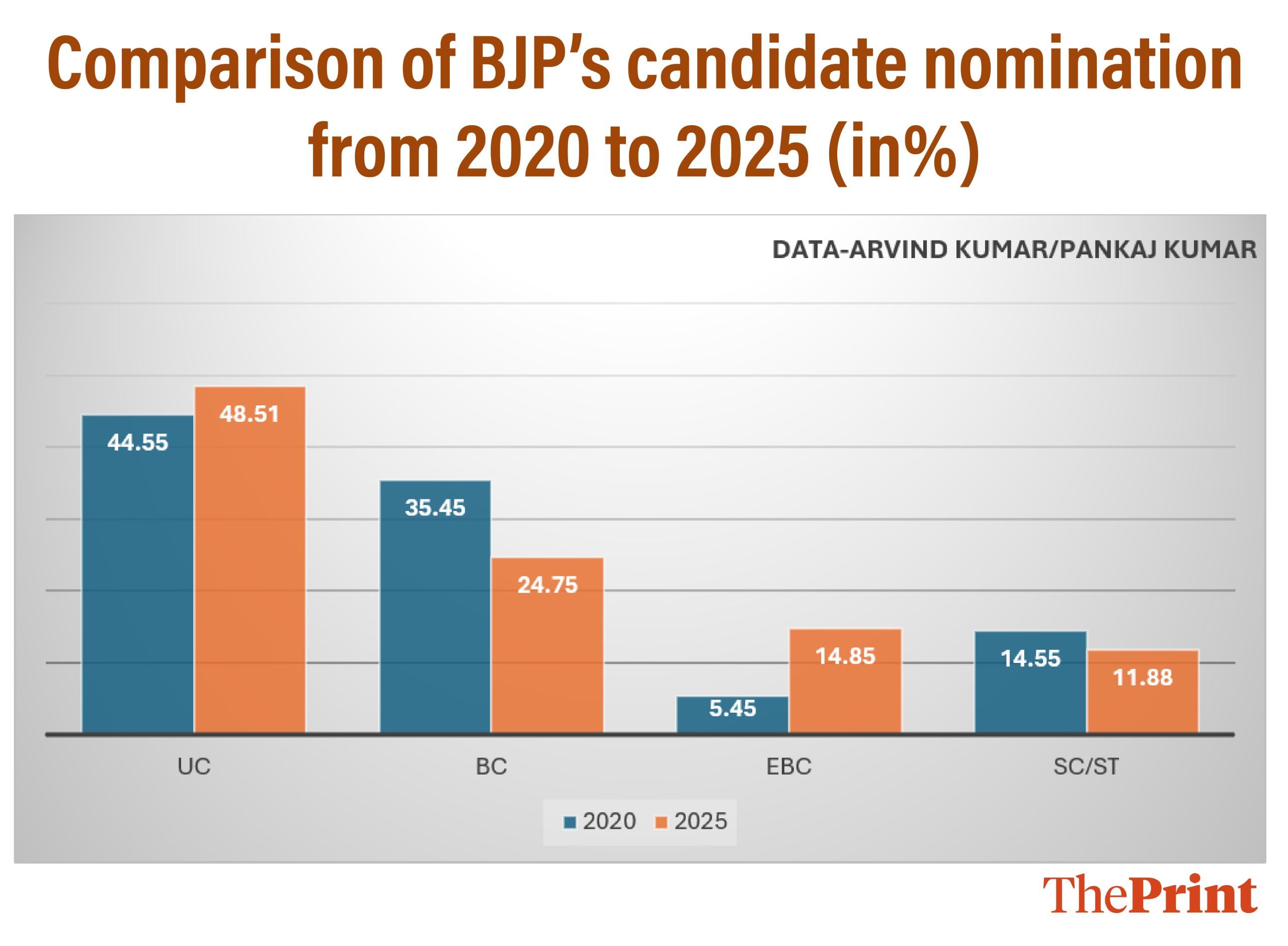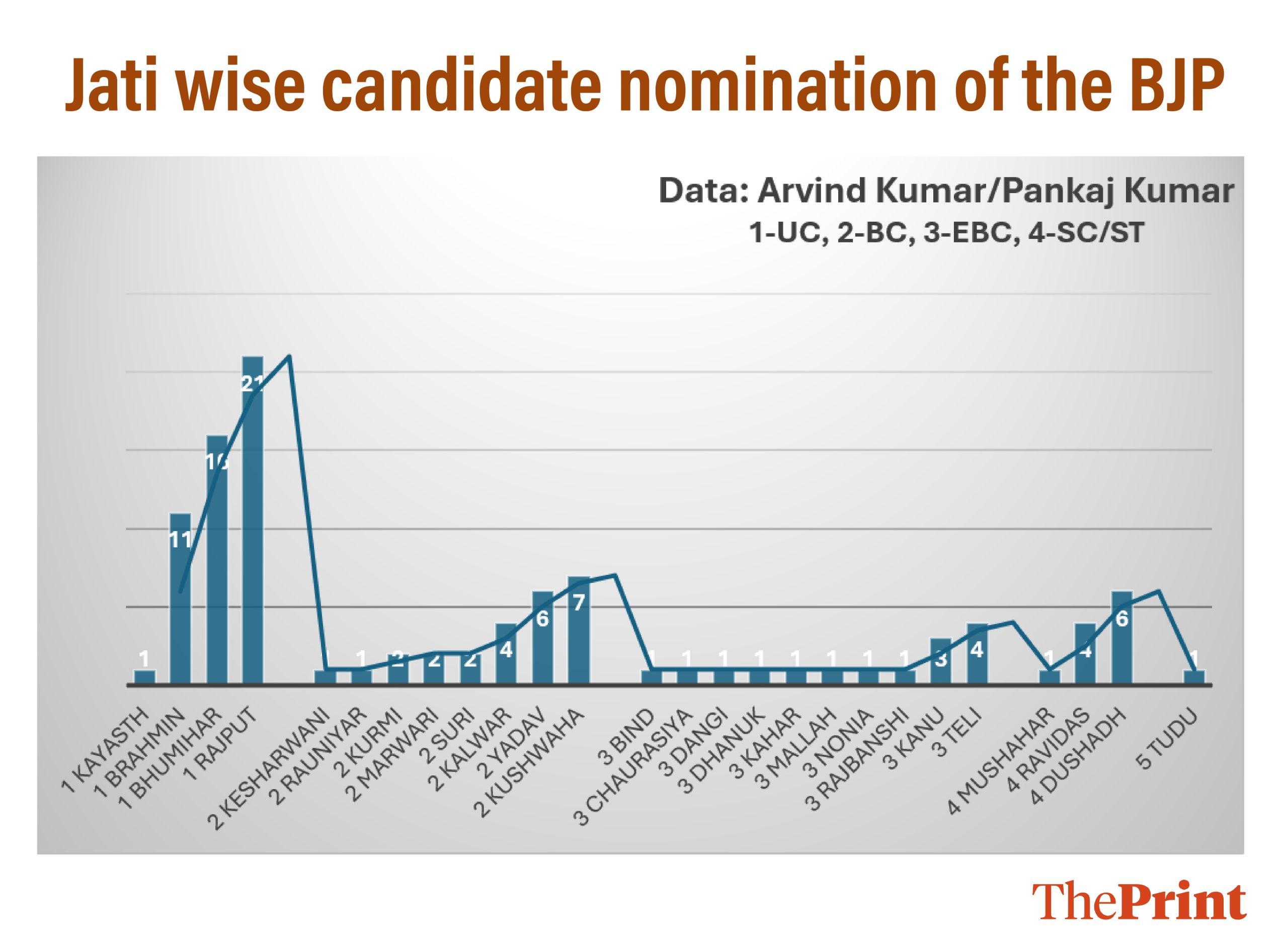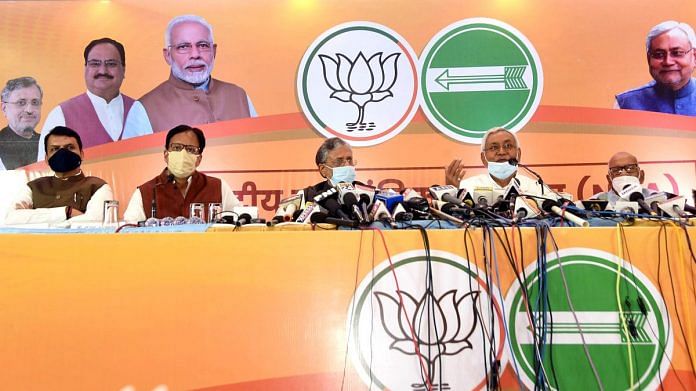Caste has become a key factor in Bihar’s ongoing electoral mobilisation. The current discussions, therefore, focus on the caste composition of candidates. In our previous article, we analysed Janata Dal (United)’s candidate caste breakdown. The National Democratic Alliance’s two other constituents, Lok Janshakti Party and Rashtriya Lok Morcha, have already publicly announced their candidate caste compositions.
This article analyses the caste backgrounds of candidates fielded by the Bharatiya Janata Party (BJP). After compiling data through interviews with local leaders and experts across Bihar, we found that half of the BJP’s candidates are from upper castes. Nominations from Extremely Backward Classes (EBCs) have also increased. It shows that the party’s focus has shifted toward the upper castes and EBCs.
Caste composition of BJP candidates
Under the NDA’s seat-sharing arrangement, the BJP has been allocated 101 seats—equal to JDU’s share, but lower than its 2020 quota of 110 seats. This time, the seat share for both parties has declined because of the entry of Upendra Kushwaha’s Rashtriya Lok Morcha (RLM) and Chirag Paswan’s Lok Janshakti Party (LJP) into the NDA, allotted 6 and 29 seats, respectively. In the last election, the LJP contested separately, causing significant losses for JDU candidates.
The BJP has declared candidates for all 101 constituencies. Figure 1 shows the caste-wise distribution of tickets across four social groups—upper castes (49), Backward Classes (25), Extremely Backward Classes (15), and Scheduled Castes/Scheduled Tribes (12). The party has not nominated any Muslim candidate. The figure reveals that around half of the BJP’s candidates are from upper castes.
Figure 1:

Also read: Medical colleges set up for Schedule Caste can’t have general quota ceiling. HC misread it
Shift from 2020 elections
Figure 2 provides caste-wise comparative analysis of candidates in comparison to the 2020 election. It reveals that the party’s nomination of upper caste candidates has increased by around 4 per cent. The nomination of EBC candidates has increased by around 9 per cent. Similarly, the nomination of candidates from backward castes has declined from 35.45 per cent to 24.75 per cent. The nomination of candidates from SCs/STs has declined from 14.55 per cent to 11.88 per cent. The latter could be due to the sharing of reserved seats with the LJP and Hindustani Avam Morcha (Secular).
However, the decline of backward caste candidates is likely to have been a strategy to mobilise EBCs and consolidate upper castes.
Figure 2:
 Jati-wise composition of candidates
Jati-wise composition of candidates
Figure 3 provides jati-wise analysis of the BJP’s candidates. It reveals that the party has nominated the highest number of candidates from the Rajput caste (21), followed by Bhumihar (16), Brahmin (11), and Kayasth (1). Among all castes, these three acquire first, second, and third position in the BJP’s nomination.
Within the Backward Castes, it has nominated the highest number of candidates from Kushwaha (7), followed by Yadav (6), Kalwar (4), Suri (2), Marwari (2), Kurmi (2), Rauniyar (1), and Kesharwani (1).
Interestingly, Kushwahas also top JDU’s list of Backward Caste candidates. It is the case despite Upendra Kushwaha’s RLM being part of the NDA. Additionally, both BJP and JDU have nominated only one candidate each from the Kayastha caste. According to research on the socio-economic inequality in Bihar based on its 2023 caste survey, Kayasthas rank highest in average household income and education. However, the pattern of nomination reveals their political sidelining.
Figure 3:
 The BJP has increased nominations of EBCs. However, within them, it has nominated the highest number of candidates from Teli (4), followed by Kanu (3), Rajbanshi (1), Nomina (1), Mallah (1), Kahar (1), Dhanuk (1), Dangi (1), Chaurasiya (1), and Bind (1) communities.
The BJP has increased nominations of EBCs. However, within them, it has nominated the highest number of candidates from Teli (4), followed by Kanu (3), Rajbanshi (1), Nomina (1), Mallah (1), Kahar (1), Dhanuk (1), Dangi (1), Chaurasiya (1), and Bind (1) communities.
The party’s approach looks to nominate as many castes as possible rather than focusing on a specific EBC group. BJP has also nominated a total of 12 candidates from SCs/STs, mainly Dusadh (6), followed by Ravidas (3), Mushahar (1), and Tudu (1), all in reserved constituencies. With two parties led by Dalit leaders, LJP and HAM(S), in the NDA, the BJP is hopeful of winning a large number of reserved constituencies.
The caste wise candidate nomination strategy of the BJP reveals that the party has nominated the highest number of its candidates from upper castes. However, its alliance partner, JDU, has nominated its highest number of candidates from the Backward Castes and EBCs. Therefore, this shows a division of mobilisation strategy among the two parties. One is focusing on the upper castes, and the other on BCs and EBCs.
Arvind Kumar is a visiting lecturer in politics & international relations at the University of Hertfordshire and an associate fellow at the Institute of Commonwealth Studies, University of London. He tweets @arvind_kumar__Pankaj Kumar is a PhD Scholar at Jamia Millia Islamia. Views are personal.
(Edited by Ratan Priya)







The print team you can not suppress free speech. Your team has not published many comments. I think this is utter shameful from a news house that writes so much about free speech. Hypocrisy at its peak
Upper caste barely constitute 10% of the state population. And getting 50% seat share. Wow this why bjp will always be upper castes party seeking votes from all in the name of hindutva but keep the select few castes in the top echelon classic Hindu philosophy of the varna system. This mindset is visible wherever bjp forms the govt. And plus this emboldens the select few to trample the rights of the Dalits and backwards. See any state under BJP rule whether it is UP MP or Haryana, the violence against weaker sections increase drastically. If BJP wins a lot number in Bihar hope they don’t turn Bihar into the Bihar of 70’s 80’s and early 90’s where the select few massacred the lower castes especially Dalits at will. BJP like the British has played divide and rule among the backwards and that is helping their causes else given their support for casteist mindset people they will never win in Bihar unless they change their attitude towards casteism and caste based discrimination. Though that seems far currently as they don’t want reformed Hinduism but a the orthodox one where the people are stratified on the basis of their birth. And the best thing they have hijacked Ambedkar and Ambedkarites 😂